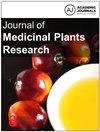Inhibition and dissolution of calcium oxalate crystals and kidney stones by the extract of Kalanchoe pinnata
引用次数: 0
Abstract
Kalanchoe pinnata leaves are used in South Asia as a natural kidney stone treatment. In vitro studies were conducted in supersaturated and artificial urine solutions to evaluate the antiurolithic properties of K. pinnata leaf extract on calcium oxalate monohydrate (COM) and surgically extracted kidney stones. Key organic acids present in the plant extract were also examined in artificial urine to investigate inhibition of kidney stone formation. Crystals harvested from inhibition and dissolution experiments were characterized by mass change, Fourier transform infrared (FTIR) spectroscopy, thermogravimetric analysis (TGA), scanning electron microscopy (SEM), redox titrations, and conductivity measurements. K. pinnata plant extract significantly inhibited crystal growth mechanisms depending on the extract concentration and supported dissolution. Crystal growth in supersaturated solutions and artificial urine was inhibited by 41 and 15 wt%, respectively, and COM and kidney stone mass decreased by 30 and 18 wt% after five extract washes. Active compounds identified in K. pinnata extract are malic, p-hydroxybenzoic, syringic, and caffeic acids, each demonstrated 2.70 to 4.65 wt% inhibition, which cumulatively accounts for the 15% inhibition observed in synthetic urine. This preliminary study demonstrates that the organic acid content of K. pinnata leaf extract is a crucial component for antiurolithic activity羽扇菜提取物对草酸钙结晶和肾结石的抑制和溶解作用
Kalanchoe羽状复叶在南亚被用作一种天然的肾结石治疗方法。在过饱和和人工尿液溶液中进行体外研究,以评估羽叶提取物对一水草酸钙(COM)和手术提取的肾结石的抗尿路结石特性。植物提取物中存在的关键有机酸也在人工尿液中进行了检测,以研究对肾结石形成的抑制作用。通过质量变化、傅立叶变换红外光谱(FTIR)、热重分析(TGA)、扫描电子显微镜(SEM)、氧化还原滴定和电导率测量对从抑制和溶解实验中获得的晶体进行了表征。根据提取物浓度和支持溶解的不同,羽生结弦植物提取物显著抑制晶体生长机制。过饱和溶液和人工尿液中的晶体生长分别被抑制了41和15wt%,经过五次提取物洗涤后,COM和肾结石质量分别减少了30和18wt%。在羽衣甘蓝提取物中鉴定出的活性化合物是苹果酸、对羟基苯甲酸、丁香酸和咖啡酸,每种酸都表现出2.70至4.65wt%的抑制作用,这累积起来解释了在合成尿液中观察到的15%的抑制作用。这项初步研究表明,锦葵叶提取物中的有机酸含量是抗尿石活性的关键成分
本文章由计算机程序翻译,如有差异,请以英文原文为准。
求助全文
约1分钟内获得全文
求助全文

 求助内容:
求助内容: 应助结果提醒方式:
应助结果提醒方式:


